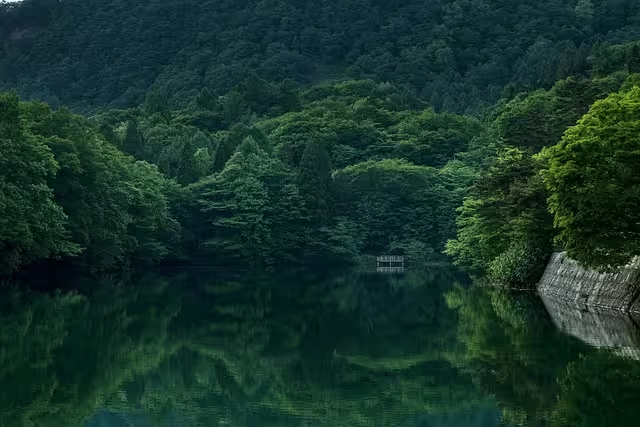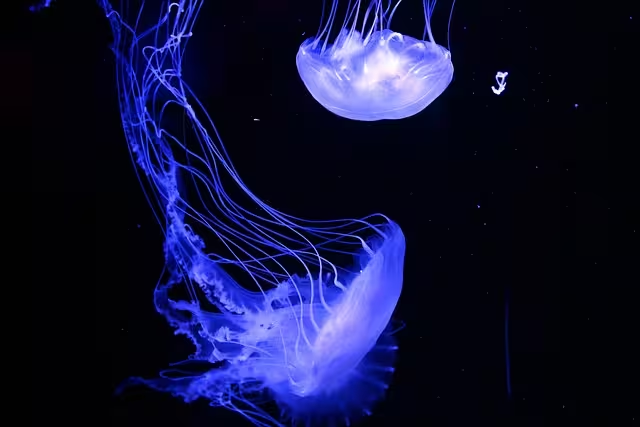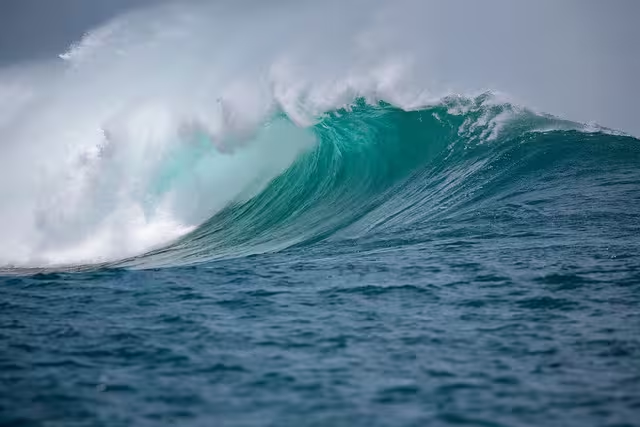There is an unseen, yet deeply felt, current that connects humanity to water. It is a fundamental element of our biology and a cornerstone of biophilic design, capable of evoking powerful feelings of tranquility, strength, and discovery. In the digital realm, we can harness this intrinsic connection. Forget the static hero image; we are moving beyond the surface. A truly immersive water-themed hero section is not merely a background video. It is a calculated, multi-sensory digital environment designed to arrest the user’s scroll, command their attention, and forge an immediate emotional connection with your brand.
This article serves as a comprehensive technical and strategic guide. We will deconstruct the “why” by exploring the psychological principles that make these designs effective. Then, we will dive into the “how,” detailing the specific HTML, CSS, and JavaScript techniques required for execution. Finally, we will navigate the strategic considerations that transform a beautiful design into a high-performing asset, ensuring you can create an experience that is not only captivating but also purposeful.
The Biophilic Blueprint: Why Water Works
The effectiveness of a water-themed hero section is not an aesthetic accident; it is a calculated design choice rooted in the principles of biophilic design. This framework posits that humans possess an innate tendency to seek connections with nature. Water, in this context, is a uniquely potent tool. Its power lies in its symbolic versatility and its direct line to our subconscious.
- Water as a Symbol of Brand Identity: The specific state of water you choose is a direct reflection of your brand’s message.

- Tranquility & Clarity: This state of water uses one of the most powerful and primordial psychological associations humans have with water. Looking at the evolutionary and biiphilic aspects; calm, clear-water signals a safe, life-sustaining environment. It is a source of hydration with hidden dangers and a place of rest and resource abundance. Using this deep-seated perception of safety and reliability is a powerful asset to exploit in a digital context. To take advantage of this power, use these features:
- Still Surfaces: Imagine a glass-like mountain lake at dawn, a tranquil infinity pool, or a serene pond. All of these examples share a lack of turbulent motion. The visual stillness gives a feeling of mental peace and stability and produces a digital space that is controlled, predictable, and non-threatening.
- Gentle, Slow Ripples: The opposite of chaotic waves, slow concentric ripples coming from a central or single point – suggest a gentle, contained action. Think of a stone being thrown into a waterbody. This feeling of subtle motion can keep the design from being static, while at the same time reinforcing a sense of calm influence and precision.
- Exceptional Clarity: This is water that is transparent in the truest sense. It allows the viewer to see the bottom. The visual purity conveyed is a metaphor for organizational transparency and honesty, showing there is nothing hidden or murky.
- Tranquility & Clarity Applications in Brand Identity: The features above are most potent when aligned with your brand’s core mission. Some examples include:
- Financial & Wealth Management Firms: These brands sell trust and stability. A hero section with a calm, clear body of water reassures at the subconscious level that their investments are in safe, steady hands. The resounding message is one of control and long-term security, providing a buffer to financial market volatility.
- Wellness & Health Brands: Businesses such as spas, meditation apps, or healthcare providers can use tranquil water visuals to immediately place the user in a state of mind receptive to healing and relaxation. The design itself becomes part of the therapeutic or calming product being offered.
- Data Security & Tech Companies: For a company handling sensitive information, a feeling of clarity is top of mind. A design featuring crystal-clear water reinforces notions of transparency, precision, and incorruptibility. Going further, it visually communicates that the company’s processes are clean, secure, and without hidden flaws.
- Power & Innovation: Powerful, moving water communicates energy, force, and transformation. This symbolism is rooted in our respect for the raw, untamable power of nature. Think of a stormy sea, a cascading waterfall, or a mighty river. These are forces of nature that carve landscapes and shape the world. When a brand aligns itself with this imagery, it is making a deliberate statement about its own role as a powerful and innovative agent of change within its industry. By employing the symbolism of powerful water, a brands taps into primal concepts of force, progress, and transformation. Some of the associated visual features include:
- Crashing Waves & Ocean Swells: This is the most telling visual for raw power. A large, cresting wave represents an unstoppable force; an entity capable of disrupting the existing order. Its use communicates brand identity that is confident, bold, and unafraid to challenge the status quo. The energy is immense and slightly dangerous, which can be appealing to those brands that need to project strength.
- Flowing Rivers & Waterfalls: Unlike the chaotic waves above, rivers and waterfalls represent relentless, directional process that never ceases. A brand using this imagery is communicating that it is always advancing, refining, and moving towards the future. It is a symbol of perpetual innovation and unwavering operational flow.
- Dynamic Splashes & Abstract Currents: This is a more modern interpretation of water that does not use literal scenes as above. Examples are a high-speed, slow-motion splash, a vortex of liquid, or stylized digital streams of water particles that accumulate energy in a more tech-forward manner. These visuals are clean, energetic, and show precision and controlled power – the “splash” of a new idea or the “flow” of data.
- Applications of Power & Innovation in Brand Identity: This symbolism is ideal for brands that want to define themselves by their dynamism and forward-thinking approach.
- Technology & Startups: If your company is aiming to disrupt the market, the imagery of a powerful wave is fitting. It tells the viewer that this brand is here to make a significant impact and change the landscape of its industry. Being associated with cutting-edge, powerful technology gives it a clear advantage.
- Automotive Brands: Connecting a high-performance vehicle with the power of nature is a well used metaphor. Here the force of a waterfall or the energy of the ocean can be used to visually represent the horsepower, speed, and engineering prowess of a car.
- Action Sports & Performance Apparel: Fashion brands want to attract an audience that values energy, endurance, and pushing limits. Imagery of powerful water directly mirrors the physical and mental state of their target demographic, creating an immediate and authentic connection.
- Creative Agencies: Creative agencies are surrounded by bold, innovative ideas and can use dynamic water visuals to represent the “flow” of creativity and its ability to make a “splash” in the market of its clients.

- Depth & Mystery: This is a more cerebral application of water. Here is the realm of the deep ocean, the abyss – a space that represents the vastness of the unknown, profound knowledge, and allure of discovery. The deep ocean represents the ultimate frontier and a place of mystery that holds both hidden wonders and immense, unseen power. A brand associated with it suggests that it offers something profound, exclusive, and not easily obtained. The visuals have subtlety, contrast, and sophisticated ambiances such as:
- Deep Ocean Scenes: Colors here are deep, abyssal blues, indigos, and even pure blacks and signify the immense pressure and distance from the surface. Occasionally, a bioluminescent light will create high contrast. The message with these colors is of serious, focused exploration.
- Underwater Light Refraction & Caustics: This effect involves shimmering and intricate patterns of light that filter through the water. This creates a dreamlike, sophisticated atmosphere that feels like conceptual space of thought and complexity. It is an intelligent, beautiful, and mysterious visual.
- Abstract Representations: These visuals can be like dark ink slowly dissolving in clear water, or microscopic particles drifting slowly through a dark space. The visuals are abstract yet organic, and suggest complex processes, the germination of ideas, or intricate workings beneath the surface.
- Applications of Depth & Mystery in Brand Identity: This feature is best suited for brands that want to cultivate an aura of intelligence, exclusivity, and profund value.
- Research Institutions, Think Tanks, & High-Level Consulting: These organizations trade in deep, specialized knowledge. Their value proposition is that they know things other do not. It suggests they have explored the depths of their subject matter and bring back rare and valuable insights.
- Luxury & High-Fashion Brands: Exclusivity is the cornerstone of luxury. By its very nature, the deep ocean is an exclusive environment. Using this imagery, can position a product as being a “hidden treasure,” something rare, precious, and something to be discovered.
- Sophisticated Technology & Software Companies: The black box of technology can represented by the deep. Having elegant, mysterious visuals assure the user that what is happening beneath the surface is incredibly powerful and sophisticated, even if the user does not completely understand it.
- How It Influences User Behavior: This symbolic communication has a tangible impact on website metrics. By creating an immediate, positive emotional resonance, you are more likely to decrease the bounce rate. The initial intrigue encourages the user to scroll further, increasing their session duration. This positive first impression primes the user, making them more receptive to the messaging and calls-to-action that follow. It’s a strategic method for guiding user perception from the very first pixel they see.
Deconstructing the Anatomy of a Water-Themed Hero Section
An immersive hero section is a sum of precisely executed parts. Each element must work in concert with the others to create a believable and engaging whole. Simply placing a video on a page is insufficient; true immersion is in the details.
- The Visual Foundation: Beyond Stock Imagery
- High-Fidelity Video: The most direct route to immersion is an HTML5 video background. However, it must be optimized. The video should be short (15-20 seconds), seamlessly looped, and compressed to a file size under 5MB, ideally under 2MB, to avoid hindering page load speed. The content itself is critical; it must be high-resolution and professionally shot to avoid appearing cheap or pixelated.
- Dynamic Image Renderings: A clever alternative to video is to animate a high-resolution static image. Using CSS and JavaScript, you can introduce subtle movements—a slow pan, a gentle zoom, or a shift in light and shadow. This provides a sense of life and dynamism with a significantly smaller performance footprint than a full video file.
- 3D Renderings & Illustrations: For ultimate brand control, a custom 3D rendering or a sophisticated vector illustration offers a unique aesthetic. This allows you to create a perfect, stylized representation of water that aligns precisely with your brand identity, ensuring no other website will have the same visual signature.
- Light & Motion: The Keys to Realism
- Light Refraction & Caustics: Realism is often conveyed through the believable rendering of light. How light bends as it passes through water (refraction) and the shimmering patterns it creates on surfaces below (caustics) are key details. These effects can be simulated using layered visuals, CSS blend modes, or more advanced WebGL shaders to create a convincing sense of depth and movement.
- Movement & Flow: The motion must feel organic. Instead of a uniform, repetitive animation, the movement should have subtle variations in speed and direction. This applies to ripples emanating from a specific point, waves that build and recede, or a current that appears to flow naturally across the screen.
- Typography as a Design Element: The text is not merely content; it is part of the scene. Font choice is critical. A fluid, calligraphic script might work for a luxury brand, while a strong, stable sans-serif provides a grounding contrast to the motion behind it. The most important consideration is readability. Text must be placed strategically in areas of lower visual noise, or given a subtle background scrim or text-shadow to ensure it remains legible against the complex, dynamic background.
The Technical Execution: Bringing the Vision to Life
The following is a breakdown of the core technologies required. Competence in HTML, CSS, and JavaScript is non-negotiable for creating a truly custom and performant immersive experience.
A. Foundational HTML Structure: The structure must be semantic for accessibility and SEO.
HTML<section class="hero-section">
<div class="video-container">
<video src="video.mp4" autoplay loop muted playsinline poster="fallback-image.jpg"></video>
</div>
<div class="hero-content">
<h1>Headline Text</h1>
<p>Subheading text that remains readable.</p>
<a href="#" class="cta-button">Call to Action</a>
</div>
</section>
The playsinline attribute is crucial for preventing fullscreen takeover on iOS devices. A poster image provides a static fallback while the video loads or if it fails to play.
B. CSS for Visual Styling & Animation:
Depth and Integration: To make text appear part of the scene, use mix-blend-mode: overlay; or mix-blend-mode: screen; on the text element. This allows the texture of the video to show through the text, integrating it more naturally than a simple solid color. Filters like filter: blur(2px); on the video can help the foreground content pop.
Simulating Movement: The CSS clip-path property is exceptionally powerful for creating organic shapes. You can animate a clip-path with animation: wave-effect 10s infinite linear; to create a reveal that looks like a moving wave front.
How do I create a water effect in CSS?: Combine animated clip-path, transform, and filter properties using CSS @keyframes to create a layered, dynamic water effect without JavaScript.
C. JavaScript for Advanced Interactivity:
Cursor Interaction: To create a ripple effect on mouse movement, you can use JavaScript to detect the cursor’s (x, y) coordinates and apply a dynamic CSS radial gradient or a WebGL shader to a canvas element positioned behind your content.
Key Libraries & Frameworks:
Three.js / WebGL: For the highest level of immersion, these technologies are the answer. They allow for the creation of interactive 3D water simulations that respond realistically to user input. This is a complex but incredibly impactful approach.
GSAP (GreenSock Animation Platform): When dealing with complex, sequenced animations, GSAP provides a robust and high-performance alternative to native CSS animations. It offers more control and better handles physics-based movements.
How can I make my hero section more interactive?: Use JavaScript event listeners (mousemove, click, scroll) to trigger animations or effects powered by libraries like GSAP for responsive, engaging interactivity.
D. Critical Performance Considerations:
How to make a video background responsive?: Use CSS to ensure the video container scales correctly (width: 100%; height: 100%; object-fit: cover;). Then, use a JavaScript-based solution or responsive image techniques (<picture> element) to serve smaller video files or even a static image to devices on slower connections or with smaller viewports.
Commonly Asked Questions

- Q: What makes a hero section immersive?
- A: Immersion is the result of a multi-layered design that engages multiple senses and creates a sense of place. It is achieved through: high-quality, full-screen visuals; subtle, organic motion that doesn’t feel robotic; interactivity that provides direct feedback to user input; and a sound hierarchy where elements (text, buttons) feel naturally integrated into the environment rather than simply placed on top of it.
- Q: Will a video background slow down my website?
- A: It absolutely can if not implemented with a performance-first mindset. The key to prevention is aggressive optimization. The video file must be compressed. It should be served via a CDN. It must have a static image fallback. And critically, you should implement logic to disable the video entirely on mobile devices, where it can consume significant data and battery, and often detracts from the user experience.
- Q: Is a water theme good for SEO?
- A: The visual theme itself is SEO-neutral. However, the effects of a well-executed immersive hero section are SEO-positive. By captivating the user, you can significantly improve engagement metrics: lower bounce rates, increased time-on-page, and higher click-through rates to subsequent pages. These are strong positive signals to search engines like Google that your page provides a valuable and engaging user experience.
Potential Pitfalls and How to Navigate Them
Creating an immersive hero section is a balancing act. It is easy to get carried away and undermine the website’s primary function.
- The “Too Much” Problem: The most common failure is over-animation. Constant, high-energy movement across the entire screen is distracting and can induce user anxiety. The goal is ambience, not a Michael Bay film. Motion should be subtle, localized, or triggered by user interaction to prevent it from overwhelming the core message.
- Sacrificing Clarity for Aesthetics: Your headline and call-to-action are the most important elements within the hero section. If they are not immediately legible and understandable within 3 seconds, the design has failed. Never sacrifice readability for an aesthetic effect. Ensure your text has sufficient color contrast and is positioned away from the most “busy” areas of the background.
- Accessibility Oversights: Motion can be a significant problem for users with vestibular disorders. It is imperative to respect the
prefers-reduced-motionmedia query. If a user has this setting enabled in their operating system, your animations should be disabled or significantly reduced. All content must remain accessible, meaning videos should not convey critical information that isn’t also present in the text.
Conclusion: Taking the Plunge
The creation of an immersive water-themed hero section is a convergence of art and science. It requires an understanding of human psychology, a mastery of modern web technologies, and a disciplined approach to user experience design. By grounding your design in the biophilic principles that connect us to the natural world, you can create a powerful first impression.
By executing with technical precision, you ensure this impression is delivered flawlessly. The techniques outlined here—from CSS animations to interactive JavaScript—are tools. Wield them with purpose to build not just a webpage, but a destination; an experience that captivates the user from the first moment and guides them effectively toward your goal. The water is there; it is time to take the plunge.

